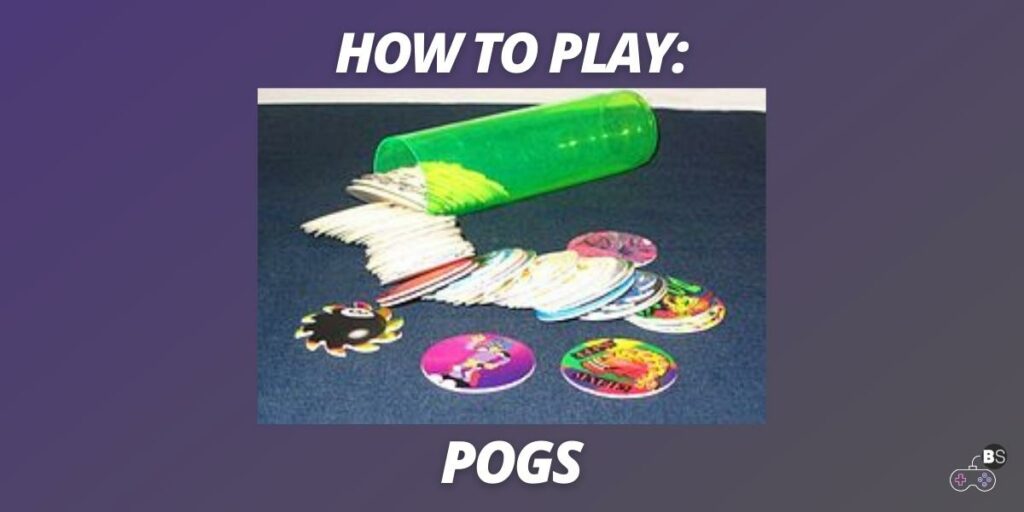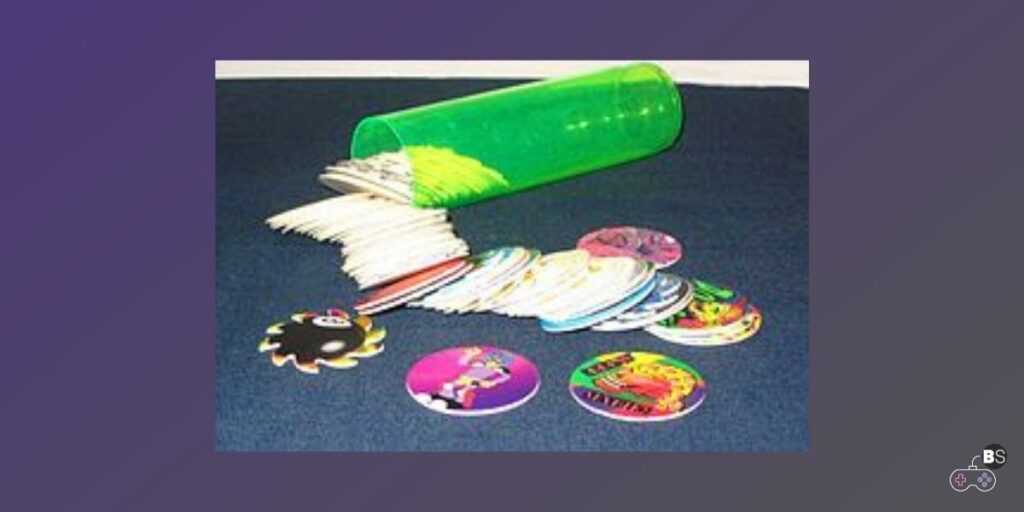Pogs are little cardboard discs that are a part of the same-named game (Pogs), which gained enormous popularity notably in the United States in the early 1990s.
Nevertheless, kids in Hawaii have been playing this venerable game since the 1920s, even though Pogs didn’t become widely popular until the 1990s.
The game was first played using POG bottle caps before it was made available commercially produced from passionfruit, orange, and guava which gave it its name ‘Pogs.’ On one side, it oft.
POG is a brand of juice en contains a picture, and on the other, they are either blank or include a simple pattern.
TLDR – Pogs were a 90s childhood staple, but the game actually has its origins in Hawaii in the 1920s. The game is played with a stack of flat discs called pogs, with each player taking turns flipping their own pog onto the stack. When a pog lands face-up, the player gets to keep any pogs that are flipped over as a result. The winner is the player with the most pogs at the end of the game.

Equipment
Pog usually uses two different kinds of playable discs: slammers and pogs to play. They are usually flat, spherical cardboard discs that have pictures on either one or both of their faces.
In contrast to modern pogs, which were stiffer, thicker, and frequently printed with vibrant, shiny images, old pogs were comprised of rougher cardboard, had fewer colors in their printing, and frequently had staples in them.
Another piece of equipment needed is a slammer, which is a solid metal disc a bit bigger than a Pog. They are a bulkier game component that is frequently constructed of metal, rubber, or more usually, plastic.
Some games forbid using metal slammers since they are often heavier than other materials, providing the player who gets the first turn an extra edge, and they frequently shatter the Pogs.
Gameplay
Before you start the game, choose the gameplay type, whether you want to play For Keeps or Not For Keeps. Everyone who participates in a game of “For Keeps” actually owns the pogs they earned. In contrast to this, players will receive their original Pogs back if they are playing Not For Keeps.
The main objective of Pogs is to amass the largest and most unique disc collection. Pogs is often played amongst a few buddies who have a large stack of them since it takes a large pot of pogs.
The purpose of the game is to accumulate all of your friend’s pogs, expanding your collection.
To participate in the game, each participant contributes an equal number of pogs. The pogs should be shuffled collectively and stacked face-up. The pogs must be arranged into a tall stack.
In order to prevent you from seeing the design side, make sure that every pog is facing down. It’s essential to ensure that the pogs start facedown since the only method for winning the game is to turn them over with your slammer.
Take the Slammer and aim it toward the pile of pogs when it’s your turn to toss. According to the regulations of the American Tournament, you should grip the Slammer within your index and middle fingers without using your thumb, flip the palm upward over the back of the wrist, and throw it.
Nevertheless, players may hold it according to their preference. No matter whether your throw hits the stack or not, you only receive one opportunity every round.
Take every pog that is currently face down or has been turned over after you throw it and keep it. The next player then takes the field after re-stacking the leftover pogs as previously.
The game finishes when there are no more pogs left. Whoever has the most pogs wins. The pogs you took while playing For Keeps should be kept. If not, give them back to their real owners. That is also how Pogs is played.
When you find any pogs you want, you can ask to play a game with your friend to decide who gets to keep them.
Ensure that you both understand that you don’t want to play for keeps.

Popularity
A generation of children who were growing up in the heyday of Nintendo was inspired to lay down their Game Boys and pick up an antiquated form of fun that was first introduced in the 1930s by a beverage business called Passion Orange Guava (POG).
POG juice was left behind in the aftermath of the game’s phenomenal popularity, however, rather than riding that wave to broaden its market presence.
Blossom Galbiso, an educator and guidance counselor at Waialua Elementary School on Oahu, is recognized as being responsible for the 1990s revival.
In order to teach math and as a non-violent substitute for other common playground games, Galbiso revived the game she previously enjoyed as a young girl to a new generation of children in 1991.
Pogs were essentially empty images for anything individuals could care about, which was another facet of the game that propelled its quick growth.
350 million Pogs were sold across the country by 1994 alone. Pog sales alone in California brought in $10 million a week. By this time, food companies were not unusual in their exploration of gaming-related marketing efforts.
During 90’s several games were launched, but none managed to sneak into people’s minds or parents’ wallets as Pogs did.
School banning
There continued to be a lot of playing happening in classrooms all across the world, which didn’t exactly sit well with parents or teachers.
The fact that pog play was effectively kid-sized gambling, which distracted children and caused fights during recess, was one minor issue. Pogs turned out to be a significant disruption in the classroom and the cause of several disputes on the playground.
As a result, the pogs and slammers were banned by schools in the US, Canada, Sweden, Iceland, Germany, the UK, and Australia, which demonstrated the end of the road for the pog craze.
World POG Federation & Pogman
Galbiso may have been the originator of POGs, however, Alan Rypinski is responsible for their widespread popularity. Bottlecaps weren’t really printed by the business; rather, Stanpac, a different Canadian business, manufactured them.
Galbiso helped Stanpac recognize that by marketing its juice caps as game pieces in the Hawaiian toy industry, it could make a fortune.
Rypinski, a businessman from California, learned about this in some way. He established the World POG Federation and obtained the “POG” brand name from Haleakala in 1993.
Things started to take a severe turn at that point. The federation used persistent marketing to make POGs the hottest playground fad in America.
The UK’s most popular brand of pogs was undoubtedly the World POG Federation or WPF. Most POGs include the POG mascot, Pogman. Several of these pogs’ series included largely amusing artwork, parodies of well-known movie sequences, or other elements of popular culture.
Pog sets
Midway through the 1990s, Skybox International, an American trading card business, also published Sky Caps, their own take on pogs. The Simpsons, Jurassic Park, and Batman Forever were among the series they featured.
This latter series, Jurassic Park, is thought to include some of the rarest pog sets. According to claims, a set of six holographic Sky Pogs from Jurassic Park that came with a slammer fetched $1,000,000.
There were also unique collectible “Space Caps” that featured artwork of the Star Trek action figures that were included with many waves of Playmates’ Star Trek action figures.
Military uses
Pog-like currency is given out as change at the Army and Air Force Exchange Service’s stores in emergency regions, which is the largest and most established exchange system inside the United States Department of Defense.
Since there were few supply flights to other countries and air freight transportation was expensive, pogs were adopted as the official currency.
In comparison to paper pogs, which are also substantially thinner than ordinary pogs, metal coinage weighs considerably heavier. Although they may only be redeemed at AAFES stores globally, they are only given in specific regions.
FAQs
Are POGs worth money?
Typically, a single Pog costs less than $1. On eBay, you might be able to get a used set for under $10. You would have been a millionaire if you had a rare pog, such as the Jurassic Park 6 Pog Hologram Set with the Slammer.
The popularity of pogs has since faded down, but playing this game with friends or family may still be a lot of fun.
How did the game POGs work?
A slammer and pogs are required to play POGs. First, each participant arranges their POGs in a stack with the picture side facing up on a level surface.
The first player then attempts to launch their opponent’s stack of POGs into the air by slamming it against them.
The cards that land face-up belong to that player; the others are re-stackable. After then, it’s the turn of the following player. Ultimately, the player with the most POGs wins. While you’re playing for keeps, the loser can end up leaving empty-handed.
How many POGs do you start with?
The minimum number of Pogs required to play isn’t specified in the regulations, and you can even use four Pogs. Playing with at least 10 to 15 pogs overall is often recommended. A minimum of that much should be in the stack.

A gaming lover from a very young age, Justin has always had a keen eye for building his own computers or racing sims so that he can race his identical twin (and usually lose at the actual race).
Justin in the founder of BeStreamer and sees it as a free resource to help all gamers around the world



